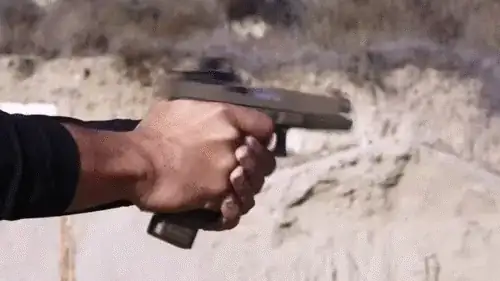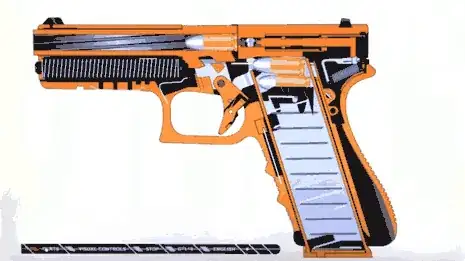Actually I'd say anything before WWI.
So here is an answer based on the little I know of strategy and warfare and also looking at the weapons themselves.
You said they won't impact the American civil war?
Well. Let's examine that. Wikipedia says that the most widely used rifle was the Springfield Model 1861 that has this joke of a rate of fire Rate: User dependent; usually 2 to 4 rounds every 1 minute.
Now to range:
Effective firing range 100 to 400 yd (91 to 366 m)
Maximum firing range 500 to 700 yd (460 to 640 m)
Now let's examine a pistol in the US military service, the Glock, just from Wikipedia to give us rough numbers.
Rate of fire for Glock 18: 1,100–1,200 RPM (rounds per minute)
Effective firing range 50 m (55 yd) (Glock 17, 17C, 18, 18C)
Now here is where it gets interesting I think.
First the accuracy of those old rifles are a joke. There is a reason why massed infantry with rifles became obsolete. A modern rifle has terrifying accuracy and legality, so staying in the open means both armies achieve insane casualty rates.
Second the rates of fire are so absurd you might as well be using laser beams against cavemen. I know that all the bullets in the world won't help if any "snipes" you from double the range. But again those were not accurate, so trying to aim and kill a person with absolutely accurate and deadly pistols with absurdly higher rates of fire is much easier.
Also on the range. First is that even a 9mm round can kill you from a 100 meters or more. Those numbers are not reflective of how far will the bullet travel and kill.
With simple iron sights and a short barrel you won't get far. But I'm certain that even at a 100 meters a 9mm round can still be effective if you train and properly use your army.
I have not tried any of that, can't even own a knife where I live, but videos on YouTube clearly shows ranges of a 100m is doable and even more are still believable.
Which leads me to the second point. You know how warfare is all about maximizing your advantages?
Got cavalry? Get an open battlefield. Got phalanx? Protect them from skirmishers and the flanks...etc.
So the important point to a commander in command of such a weapon is to maneuver and deploy his troops where the range is not an issue. This is difficult, but most warfare is all about that honestly. So if the commander is at least decent, they will put their soldiers where 50-100 meters are enough, and their much deadlier rounds and insanely higher rates of fire can come into effect.
Perhaps such a commander can use the following.
Ranged cavalry. They were a thing right from the start. Bows, spears, darts, you name it.
Even with gunpowder you had stuff like Dragoons and Cuirassier and many many other historical units utilized guns and special guns, usually shorter and hopefully faster, in their armaments. This makes it so that the cavalry can close the gap quickly, nullifying the range advantage, and produce a hail of fire that will annihilate any army.
Also "urban" combat will be completely dominated by the commander that posses semi-automatic pistols. In fact you can defend a city with much much smaller numbers because in an urban setting a modern semi-automatic will rule to points of broken video game levels of cheese. Also using cover and the fact that the older guns is not accurate only adds to the side with semi-automatic pistols coming out on top. And with no modern artillery, no tanks, no guides missiles, no drones...etc, flushing out defenders from a city is nearly impossible.
This can also lead to smaller more maneuverable units being more deadlier against the opposing army especially the flanks and the supply train. Again imagine armored cavalry with semi automatic pistols that uses hit and run tactics against a slower army.
That might also increase castle or forts or whatever. Purely military structures with reinforced walls that houses your little mounted devils.
So to answer your question, I'm positively certain that anything short of battle rifles, you know the historical ones from WWI and before, falls short of modern automatic pistols if used correctly.
You also need to understand that small inaccuracies, much like chess, can lead to bigger advantages in a war. The Roman army, just a famous example, utilized smaller supply trains and that alone changed history more than a mega super weapon. Same with strong English logbows or smaller mounted composite bows or fully plated knights...etc.
So to be clear I don't mean that an automatic pistol means: insta win.
More like if used properly and in the hand of a decent general they will have a huge effect on the war.Sure if you drown your enemy in numbers in something like 10 to 1 battles you might count it. All is possible with enough resources. But that's a bit silly. But again most of the time even small differences can lead to big results on the battlefield.
I mean Napoleon was not using plasma and Caesar was not leading demons...etc.
So yeah. Even against muskets semi-automatic pistols are amazing, and certainly every single war in history before that.
Edit: all that is you only counting the basic guns. Add longer barrels and better sight, or heck scopes, and they become way better than incarcerate old muskets with awful rates of fire and smelly powder that are long heavy and cumbersome.
Edit: as "Rhandal Allen" pointed out the Glock 18 is automatic.
So here is what Wikipedia says:
"A semi-automatic firearm typically has an effective firing rate of 40 rounds per minute"
And looking for more answer it seems that 60–80 rounds is a good average rate of fire per minute for a semi-automatic pistol.
Obviously that's less than an automatic pistol but again that rate is absurd. And obviously there is a huge variety even within the semi-automatic world. Be it magazine or caliber...etc.
Lastly I wish to add that the
"Heckler & Koch USP" has a Maximum firing range of 100 m
(Wikipedia again)
And that is actually pretty good for even modern combat. I mean sure a modern automatic rifle can effectively engage a target at 500 meters but without special equipment and good visibility your chances of hitting that target is pretty slim.
And according to this article the "Almost all interviewed stated all firefight engagements conducted with small arms (5.56mm guns) occurred in the twenty to thirty (20-30) meter range. Shots over 100m were rare"
Now I'm not sure about this because context is king here. If you are defending a perimeter then the distance might be higher and if you are engaged in urban combat you might be limited to lower ranges and so context dependent is the best answer.
Yet a number of 100-200 meters, I've actually looked up some google results for it, seems like a pretty good modern average.
So even the "range" issue is becoming less and less of an issue with actual statistics and actual combat examples.
So I stand with my answer. Also sorry for the mix up.

